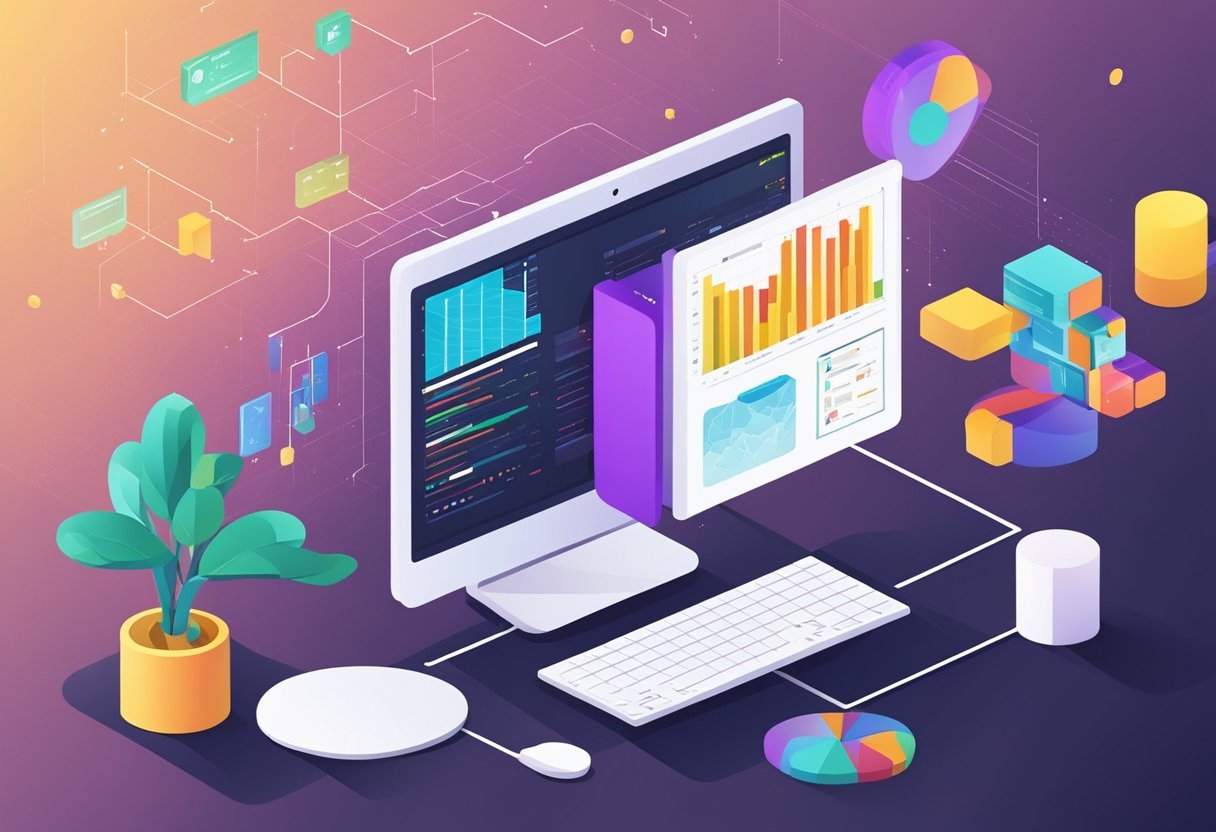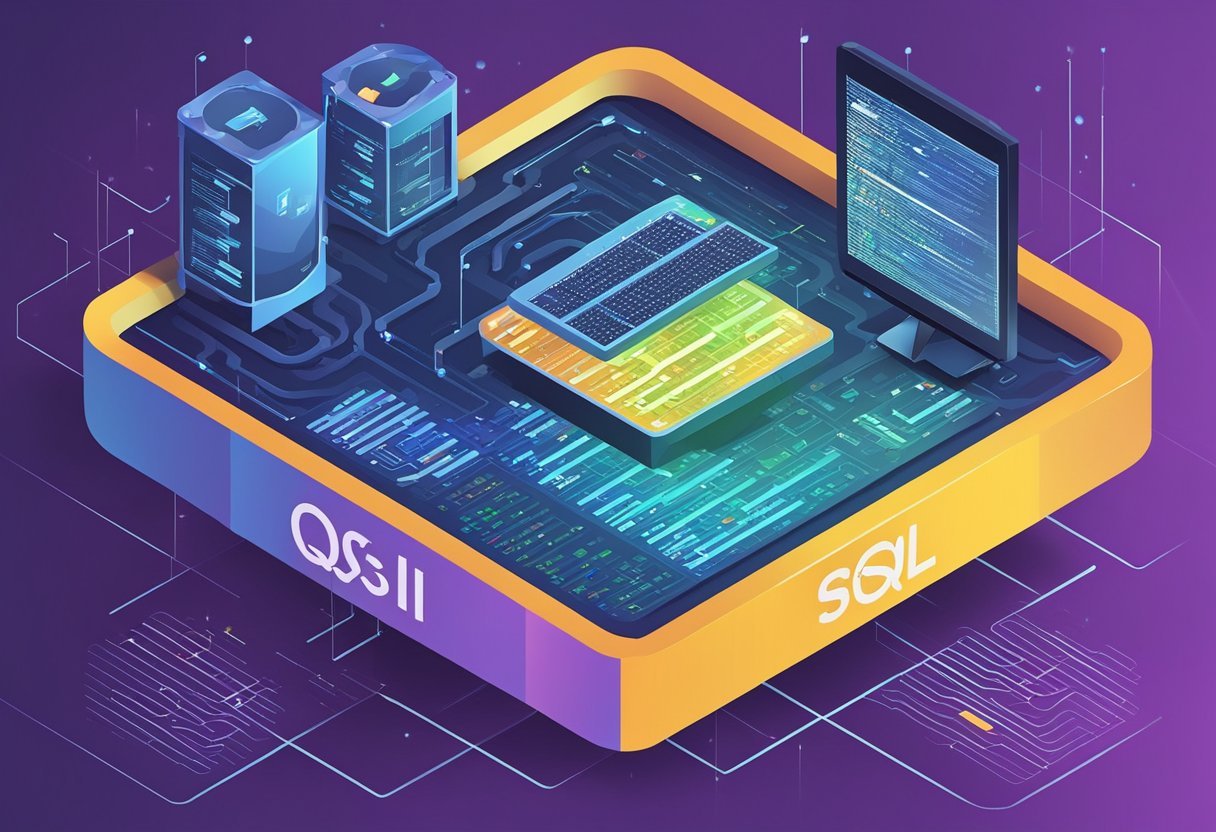Foundations of Python and SQL
Python and SQL are essential programming languages in data science. Python is popular for its ease of use and versatility in handling various data structures.
It allows for comprehensive processing, statistical analysis, and creating advanced visualizations. Python libraries such as Pandas and NumPy provide powerful tools for data manipulation.
SQL, or Structured Query Language, plays a vital role in managing relational databases. It excels at querying and manipulating data stored in these databases.
Users can efficiently retrieve, update, and manage large datasets with SQL’s straightforward syntax.
Here’s a brief comparison:
| Feature | Python | SQL |
|---|---|---|
| Purpose | General programming | Database management |
| Usage | Data analysis, scripting | Querying databases |
| Strengths | Versatility, data structures | Data retrieval, speed |
Using these two languages together enhances data tasks significantly. Python can connect to databases using libraries like SQLAlchemy, allowing users to run SQL queries directly from a Python environment.
This integration helps in automating repetitive tasks and combining data manipulation with analytical functions.
For those new to these technologies, it’s important to start with the basics.
Begin by understanding how to connect Python to databases and execute SQL queries within Python.
As you gain proficiency, you can explore advanced techniques like views, joins, and transactions in SQL, along with Python’s more complex data handling capabilities.
Setting Up Your Development Environment

To work effectively with Python and SQL, it’s crucial to have a well-prepared development environment. This involves installing Python, selecting and setting up a SQL server, and integrating the two using tools like Jupyter Notebook.
Python Installation and Anaconda
Start by installing Python from the official Python website. Choose the version that suits your operating system.
For data science projects, it is often recommended to use Anaconda, which simplifies package management and deployment.
Anaconda includes popular Python libraries and tools. This makes setting up environments easier without manually handling dependencies.
After downloading Anaconda, follow the installation instructions and make sure to select “Add Anaconda to my PATH environment variable” during installation.
SQL Server Selection and Installation
Selecting a SQL server depends on your project needs. Microsoft SQL Server and Oracle are popular options. These SQL servers come with robust data handling and advanced security features.
For installation, download the setup files from the official websites.
Microsoft SQL Server includes a feature-rich setup assistant that guides you through the configuration process. Ensure to enable the required services during installation.
It’s important to set up proper authentication for security purposes.
Integrating Python and SQL with Jupyter Notebook
Integration of Python and SQL can be achieved through Jupyter Notebook, which allows for interactive data exploration.
To get started, initiate a Jupyter session through Anaconda Navigator or use the command line with jupyter notebook.
Utilize libraries such as pyodbc for connecting Python with SQL databases.
Write SQL queries directly within Jupyter cells and analyze data with Python code. Linking with platforms like GitHub can also facilitate version control.
This setup creates a powerful environment for data analysis, combining Python’s flexibility with the structured querying capabilities of SQL.
Database Operations with Python
Understanding how to manage and manipulate databases with Python enhances SQL skills significantly. Key tasks include connecting to databases, running queries, and performing administrative tasks.
Connecting to SQL Databases
Establishing a connection between Python and an SQL database is fundamental. This involves using libraries like sqlite3 for SQLite databases or mysql.connector for MySQL.
The connection setup requires specifying parameters such as host, user, and password. A secure connection ensures data integrity and accessibility, which is crucial for any database-related operations.
Detailed connection strings are often needed to define the server details and credentials, ensuring seamless integration between Python applications and the database systems.
Executing SQL Queries
Running SQL queries in Python allows data retrieval, insertion, updating, and deletion within the database. Python libraries facilitate these operations, providing functions to execute SQL commands directly.
For instance, using cursor.execute() with appropriate SQL statements can manipulate data efficiently.
Result sets are often returned for SELECT queries, enabling further analysis or processing within Python.
The flexibility of executing complex SQL queries in a Python environment helps streamline data operations and integrate data engineering processes with ease.
Database Administration
Python can aid in database administration tasks such as creating tables, managing indexes, and setting user permissions.
These tasks are essential for maintaining database integrity and performance.
Administrative libraries and scripts can automate routine tasks, ensuring databases run smoothly.
Python’s ability to script these operations makes it a vital tool for database administrators (DBAs) who manage and oversee database environments.
Regular maintenance activities are simplified when automated through Python, reducing downtime and enhancing database reliability.
Advanced SQL Techniques
Advanced SQL techniques can optimize data processing by improving query performance and ensuring data security. These methods include crafting complex queries through different join operations, utilizing views and stored procedures for better data handling, and managing transactions to enhance database security.
Complex Queries and Joins
Complex queries involve using multiple tables and operations to retrieve specific data. They often include joins, which connect tables based on shared fields.
There are several types of joins: INNER JOIN, LEFT JOIN, and RIGHT JOIN.
INNER JOIN returns records with matching values in both tables. LEFT JOIN returns all records from the left table and matched records from the right table. RIGHT JOIN is the opposite of left join, returning all records from the right table.
With these joins, users can create queries that pull together data from different tables efficiently. The choice of join type depends on what data relationships are needed.
Views and Stored Procedures
Views are virtual tables that allow users to save frequently-accessed complex queries. They provide a way to simplify and encapsulate complex SQL logic.
Views help in presenting data in a specific format without altering the actual tables.
Stored procedures are sets of SQL statements that are stored in the database. They allow for complex operations to be executed with a single call.
This can be useful for reusing code, enhancing performance, and maintaining security since users typically get access only to the stored procedure and not underlying data.
Both views and stored procedures foster efficient data management and help maintain consistency across SQL applications.
Transactions and Database Security
Transactions ensure that database operations either fully complete or don’t happen at all, maintaining data integrity.
SQL’s ACID (Atomicity, Consistency, Isolation, Durability) properties are critical for transaction management.
Atomicity ensures all parts of a transaction are completed. Consistency guarantees data remains accurate after a transaction. Isolation keeps transactions separate from one another. Durability ensures completed transactions persist, even after system failures.
Incorporating these properties in database operations strengthens security and reliability, making them a vital part of advanced SQL techniques.
Security is further enhanced by controlling access and monitoring SQL operations to safeguard against unauthorized changes or breaches.
Data Manipulation with Pandas

Pandas, a powerful Python library, streamlines data manipulation and analysis. It excels in extracting and transforming data, and seamlessly merging SQL data with pandas DataFrames.
Data Extraction and Transformation
Pandas makes extracting and transforming data straightforward. By leveraging functions like read_csv, read_excel, or read_sql, pandas can efficiently extract data from various formats.
These tools allow users to import data directly from CSV files, Excel spreadsheets, or SQL databases.
Once the data is extracted, pandas offers a suite of transformation tools. Users can clean data using functions like dropna to handle missing values or fillna to replace them.
The apply function allows for complex transformations tailored to user requirements. With the ability to integrate seamlessly with NumPy, pandas ensures high-performance mathematical operations, enhancing the data transformation process for large datasets.
Merging SQL Data with pandas DataFrames
Pandas offers robust ways to merge SQL data with pandas DataFrames, providing a unified environment for data analysis.
Using the read_sql function, data can be directly imported into a DataFrame. This allows users to bring SQL efficiency into Python for further manipulation.
The merge function in pandas is particularly useful when combining data from different sources. Users can perform join operations similar to SQL, such as inner, outer, left, or right joins.
This flexibility enables users to manipulate and analyze data without switching between SQL and Python environments.
The ability to retain complex relationships between datasets while using pandas enhances the overall data analysis workflow.
Check out how pandas can be leveraged for advanced SQL queries to deepen understanding and efficiency.
Data Visualization and Reporting

Data visualization and reporting with Python offer powerful ways to interpret SQL data. Using Python libraries, visuals can be created that enhance data science efforts. With SQL databases, these visuals become part of effective and informative reports.
Creating Visuals with Python Libraries
Python provides several libraries to create data visualizations. Matplotlib is one of the most popular choices for creating basic plots, such as line and bar charts, and has a simple syntax that is easy to learn.
Another library, Seaborn, builds on Matplotlib and provides more advanced styling options to make the visuals more appealing.
For interactive visualizations, Plotly is often used. It allows users to create dynamic charts, adding features like hover-over information and clickable elements.
These libraries help transform raw data into clear and intuitive visuals, making data more accessible.
Incorporating SQL Data into Reports
Combining SQL data with Python’s visualization capabilities enhances reporting.
SQL databases store vast amounts of structured data, which can be queried using SQL to extract relevant information.
Once retrieved, this data can be handled using Python’s data manipulation library, Pandas, which allows for comprehensive data processing.
The refined data is then ready for visualization, turning complex datasets into easy-to-understand reports.
This enables better decision-making for businesses and researchers.
By linking data from SQL databases with Python’s visualization tools, the potential for insightful data storytelling is significantly enhanced.
Incorporating SQL data into reports aids in presenting findings clearly and effectively, bridging the gap between data retrieval and data presentation.
Data Science Workflows
Data science workflows are essential for transforming raw data into valuable insights. They involve querying data, modeling datasets, conducting statistical analysis, and integrating machine learning techniques. These steps ensure that data analysts can make informed decisions based on reliable data.
From Querying to Modeling
Data science begins with collecting and preparing data. Data scientists use tools like SQL to query data from databases.
This involves selecting, filtering, and aggregating data to obtain the necessary datasets for analysis.
Once the data is ready, the next step is modeling. In this phase, data scientists develop and refine models to understand patterns and relationships within the data.
Modeling involves choosing the right algorithm, training the model, and validating its accuracy. This step is crucial for ensuring that predictions or insights drawn from the data are reliable.
Statistical Analysis and Machine Learning Integration
Statistical analysis plays a critical role in data science workflows. By applying statistical methods, data scientists can identify trends, test hypotheses, and draw conclusions.
This helps in understanding the underlying structure of the data and supports informed decision-making.
Integrating machine learning extends these capabilities by enabling predictive modeling and automation of complex tasks.
Machine learning algorithms learn from past data to make future forecasts. This integration enhances the accuracy of predictions and allows for more dynamic data-driven solutions.
Machine learning helps in processing large datasets efficiently, providing scalable insights that can adapt over time.
SQL for Business and Data Analysts
Business and data analysts use SQL to unlock valuable insights hidden within large datasets. SQL helps in analyzing business metrics and generating insights essential for making data-driven decisions.
Analyzing Business Metrics with SQL
Business analysts often rely on SQL queries to examine key performance indicators. By querying databases, they can track sales, profit margins, and customer engagement.
This analysis guides strategic planning and resource allocation.
SQL’s strengths lie in its ability to aggregate data, allowing analysts to perform operations such as sums and averages quickly. They can identify trends over time and compare performance across different business units.
For example, joining tables helps merge sales data with marketing efforts, providing a fuller picture of a company’s performance.
Filtering and sorting capabilities in SQL are essential for narrowing down data to specific time periods or products. This precision helps analysts focus on the most relevant metrics.
By understanding the finer details, business analysts can recommend changes or enhancements to improve outcomes.
Generating Insights for Data-Driven Decisions
Data analysts use SQL to translate raw data into actionable insights. This process involves structuring complex data sets to reveal patterns and correlations.
Insights derived from SQL queries facilitate informed decision-making and strategic developments.
One way SQL supports this is through creating views. Views allow analysts to simplify complex queries and present data in a readable format.
Such views often serve as the foundation for dashboards that communicate findings to stakeholders clearly.
Analyzing demographic data or customer feedback becomes straightforward. By employing grouping functions, analysts discern differences among various customer segments, informing targeted marketing strategies.
Combined with visualizations, these insights become powerful tools for shaping business direction.
Implementing Data Engineering Pipelines

Implementing data engineering pipelines involves using Python to create efficient workflows for data collection and transformation. Python scripts automate tasks in managing and querying databases, integrating skills in programming and SQL commands.
ETL Processes with Python
Extract, Transform, Load (ETL) processes play a critical role in data engineering. Python provides powerful libraries like Pandas, allowing programmers to process large volumes of data efficiently.
In the extract phase, data is gathered from various sources. Python can connect to databases using libraries such as SQLAlchemy, querying databases to fetch data.
The transform stage involves cleaning and modifying data, ensuring it is usable. Finally, the load phase involves writing data back to a database, using Data Manipulation Language (DML) commands to insert, update, or delete records.
Automation of Data Workflows
Automation is crucial for maintaining robust data systems. Python, known for its simplicity and versatility, excels in this area.
Tools like Apache Airflow allow data engineers to schedule and monitor workflows, reducing manual intervention.
By crafting scripts to automate tasks, engineers can use Python to automate recurring database queries, manage data transformations, and monitor workflow efficiency.
Incorporating Data Definition Language (DDL) commands, Python can help modify schema definitions as needed, further simplifying administration.
This reduces errors, speeds up processes, and ensures data accuracy, ultimately boosting productivity in handling data engineering tasks.
Career Advancement in Data Fields
To advance in data fields, individuals can build a robust portfolio and gain certifications. These steps are essential for showcasing skills and demonstrating continuous learning in a competitive job market.
Building a Portfolio with GitHub
Creating a portfolio on GitHub is crucial for those in data fields. It serves as a digital resume, highlighting practical experience and projects.
Individuals should include a variety of projects showcasing different job-relevant skills, such as data analysis and machine learning.
Hands-on projects can be developed using platforms like learnpython.com to show SQL and Python expertise.
Sharing projects on GitHub also encourages collaboration with other professionals, providing valuable feedback and learning opportunities.
Certifications and Continuous Learning
Certifications are another important component for career growth in data fields. Earning a career certificate from platforms like Coursera can enhance a resume.
Coursera offers courses with a flexible schedule that fit diverse needs.
Subscribing to Coursera Plus grants access to a wide range of industry expert-led courses.
These certifications are shareable and recognized by employers, aiding in career advancement. For continuous learning, platforms such as learnsql.com provide interactive courses that help to keep skills updated and relevant.
Frequently Asked Questions
Python and SQL work well together, allowing users to combine Python’s flexibility with SQL’s database management strengths. Learning both can enhance data manipulation skills, improve job prospects in data science, and offer access to various free and paid courses for further advancement.
What are the best resources for learning Python and SQL together?
Several courses offer integrated learning experiences for Python and SQL. For instance, the Data Science Fundamentals with Python and SQL Specialization on Coursera provides a structured path.
Sites like Dataquest and LearnSQL offer more hands-on tutorials and guides.
How can familiarity with Python improve my SQL data manipulation?
Understanding Python can enhance SQL data processing by allowing automation of queries and advanced data analysis. With Python, users can easily handle datasets, clean and visualize data, and perform complex analyses that might be challenging with SQL alone.
Which certifications are recommended for proficiency in both SQL and Python?
Certifications from platforms like Coursera or specific data science tracks from technical education programs can validate skills.
Look for courses that offer comprehensive coverage of both languages and practical, real-world applications.
Are there any comprehensive courses available for free that cover both SQL and Python?
Yes, several platforms provide free access to beginner and intermediate level courses.
For example, some universities offer free courses on platforms like Coursera or edX, covering the basics of both SQL and Python. These often include trial periods or financial aid options.
How does mastering Python and SQL impact employment opportunities in data science?
Proficiency in both Python and SQL is highly valued in data science. Many employers seek candidates who can perform data analysis and database management across multiple tools.
This skill set is critical for roles ranging from data analysts to machine learning engineers.
In what ways has SQL evolved by 2024 to integrate with modern programming languages like Python?
By 2024, SQL has continued to evolve, incorporating features that enhance integration with languages like Python.
This includes improved libraries for data manipulation, support for complex data types, and enhanced performance for large-scale analyses commonly needed in big data applications.
